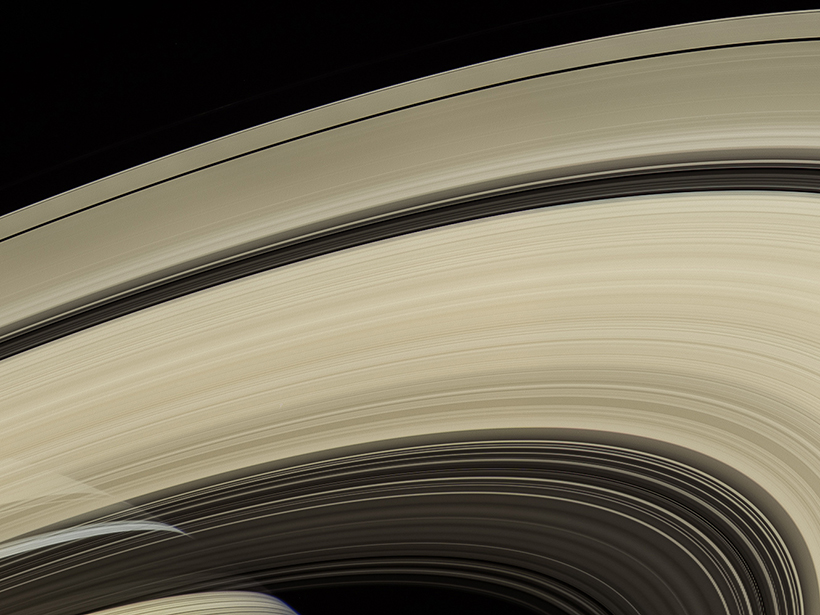For more than a decade, the Cassini spacecraft had perhaps the most spectacular view in the solar system.
Time after time it looped around Saturn, viewing the magnificent rings from many angles. It plotted individual ringlets, spotted waves and ripples, and discovered “propellers” and other odd features embedded in the ring system.
And then the view got better. During its final 22 orbits, Cassini dipped into the space between Saturn’s cloud tops and the inner edge of the rings, passing so close to them that it had to use its radio dish as a shield against ring particles.
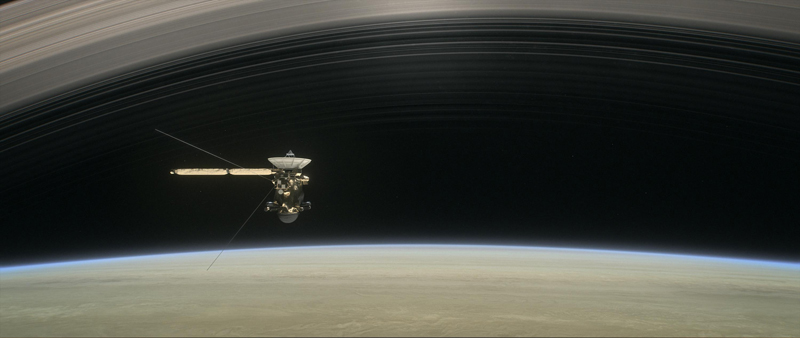
That perspective produced some impressive science as well as impressive views. Cassini’s observations revealed the mass of the rings and provided better estimates of when they formed and how long they might continue.
“Prior to Cassini’s finale, there were two big unknowns, and those have now been addressed: What is the mass of the rings, and what is the mass-loss rate of the rings,” said Luke Moore, a senior research scientist at Boston University.
From those measurements, researchers concluded that we happen to be seeing Saturn’s rings in the middle of a relatively short life span, which began perhaps 100 million years ago and might last 100 million years longer.
Cassini’s ring discoveries didn’t end there, however. The craft flew through “ring rain”—a shower of particles from the rings into Saturn’s atmosphere—which allowed it to directly measure the rings’ composition. Its instruments also measured the effects of ring rain on Saturn’s atmosphere. And scientists even used the appearance of the rings to deduce the length of Saturn’s day, adding one more accomplishment to Cassini’s reconnaissance of Saturn’s rings.
Becoming “Lord of the Rings”

Saturn’s main rings span about 275,000 kilometers—roughly two thirds of the distance between Earth and the Moon—although their average thickness is no more than a few tens of meters. From outside to inside, the rings are labeled A, B, C, and D, with the first three consisting of many smaller individual rings. (A few faint, low-mass rings lurk outside the A ring, but they are insignificant compared to the main bands.) A and B are wide and dense, and they contain most of the ring system’s mass.
The C ring helped astronomers solve a perplexing mystery about Saturn: the length of its day, which had been difficult to pin down.
Chris Mankovich, a graduate student at the University of California, Santa Cruz, studied waves in the C ring for his Ph.D. thesis. Those waves are generated by motions of layers several thousand kilometers below Saturn’s cloud tops.
“Mass inside the planet sloshes back and forth, and the rings ‘feel’ that through gravity,” he said.
Ring waves helped scientists calculate Saturn’s rotation rate: 10 hours, 33 minutes, 38 seconds.
Cassini detected the waves by measuring stellar occultations by particles in the C ring, which is much less dense than the A and B rings. The exact pattern of the waves reveals the planet’s motions, which Mankovich then used to calculate Saturn’s rotation rate: 10 hours, 33 minutes, 38 seconds.
Most of the ring research, though, was focused on the rings themselves and on their interactions with Saturn’s atmosphere. Cassini passed inside the ghostly D ring, which comes within about 6,500 kilometers of Saturn’s clouds—so close that it’s immersed in the planet’s tenuous outer atmosphere, known as the exosphere.
Cassini’s dips inside the D ring were part of the craft’s grand finale, a 5-month mission phase that ended with Cassini’s demise on 15 September 2017.
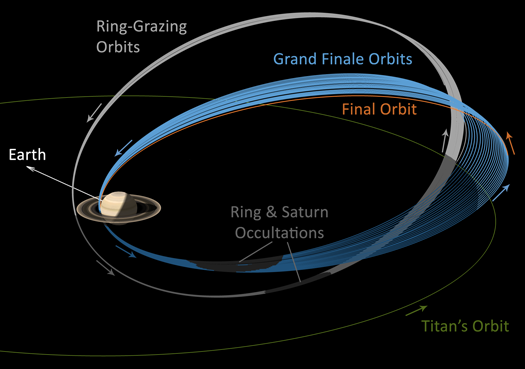
As Cassini depleted its propellants, mission planners decided to end its journey by slamming it into Saturn’s atmosphere, where it would burn up. That would eliminate the risk of it hitting the moons Titan and Enceladus, which show evidence of habitability, and possibly contaminating them with terrestrial microbes that might have survived the rigors of space.
Engineers devised a flight path that would take advantage of Cassini’s end to provide new insights into Saturn and the rings. As Cassini spiraled closer to Saturn, it was set to probe the planet’s interior with greater fidelity, get a more detailed look at its cloud tops, and study the rings from a new angle.
Among the grand finale’s most important discoveries, that “inside-out” angle allowed scientists to make the best measurement yet of the mass of Saturn’s rings.
When it remained outside the rings, Cassini was pulled by the combined gravity of Saturn and the ring system, so it was difficult to isolate the tug of just the rings. When Cassini passed inside the rings, however, Saturn pulled the craft in one direction while the rings pulled in another.
Precise radio tracking revealed the rings’ gravitational effect on Cassini’s path, which allowed scientists to calculate their mass: 41% the mass of Saturn’s small moon Mimas (plus or minus 13%), or 0.05% the mass of Earth’s moon—roughly half the value of many pre–grand finale estimates.
“My favorite comment about this research came from a Russian website, which basically said that we found when Saturn became ‘Lord of the Rings.’”
When combined with other parameters, the mass allowed scientists to estimate the age of the rings as well.
In a paper in Science, published in January, radio science team members assumed that the rings began as almost pure water ice and have been darkened by meteoroidal material from outside the Saturn system, which falls onto the rings at a well-known rate. The darkness of the rings reveals the ratio of ice to rock, which in turn reveals their age: between 10 million and 100 million years.
“They can’t be older than about a hundred million years because they would be darker,” said Burkhard Militzer, an associate professor of Earth and planetary science at the University of California, Berkeley, and an author on the paper. “That tells us conclusively that the rings are very young. My favorite comment about this research came from a Russian website, which basically said that we found when Saturn became ‘Lord of the Rings.’”
“The age isn’t a solved problem, but it does narrow down the error bars,” said Moore. “It’s consistent with the rings of the other giant planets. They are very different environments, but the fact that we don’t see similarly large systems at Jupiter or the other planets would be consistent with a young age for Saturn’s rings, which, over time, would just sort of evaporate away.”
Ringing in the Rain
Cassini’s observations may also help scientists determine how the rings formed. One idea says they were born when Saturn’s gravity pulled apart a passing comet and the remains encircled the planet, whereas another says they formed from one or more collisions between small moons or between a moon and a comet.
Clues to the origin may come from Cassini’s direct measurements of ring material. As it plunged through the ring plane, the spacecraft detected a surprisingly heavy “rain” of organic-rich neutral particles onto the equator—enough to drain the rings away in a hurry.
Scientists had already detected an infall from the rings at the planet’s midlatitudes, which Moore describes as “classic ring rain” because it was the first ring rainfall to be described. It was first predicted in the 1980s on the basis of Voyager measurements of the ionosphere. Scientists noted an unexpected dip in the charge of the ionosphere at certain latitudes, as well as dark zones in the clouds.
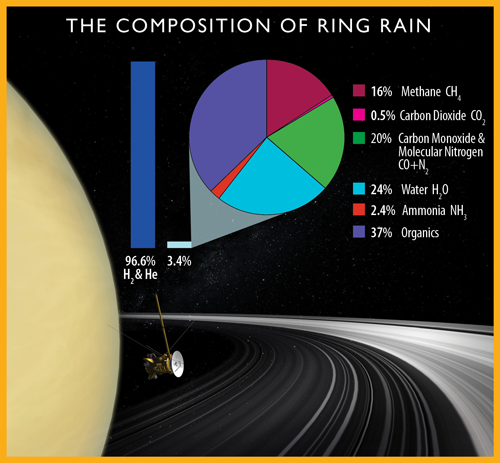
Micrometeorites may be striking the inner portion of the B ring, creating a plasma. Some of the plasma particles follow Saturn’s magnetic field lines toward the planet, falling into the atmosphere along the observed latitude bands. The particles combine with electrons in the ionosphere, reducing the electron density at those latitudes. The rain also clears out high-altitude haze, allowing us to see deeper into the atmosphere, producing the dark zones.
A study published earlier this year in Icarus, based on a reanalysis of Keck Telescope observations from 2011, confirmed the infall in bands around 45°N and 39°S latitude. The study says that this process is delivering roughly 432 to 2,870 kilograms of water to Saturn’s midlatitudes every second, enough to drain the rings in about 300 million years.
Cassini confirmed the ground-based findings. But it also found that this rainfall may be a mere shower compared to the influx at Saturn’s equator.
The Cosmic Dust Analyzer, for example, found that the region between the D ring and the outer atmosphere is filled with a fairly constant population of grains of water ice and silicates that are a few tens of nanometers across.
The Magnetospheric Imaging Instrument (MIMI), which was designed to measure energetic neutral atoms, ions, and electrons, detected even smaller grains (comparable to the size of smoke particles) at altitudes of about 1,700 to 3,000 kilometers above the planet’s equator.
“There was no expectation of dust right at the equator, so the fact that Cassini found a population concentrated there was quite a surprise,” said Don Mitchell, a staff physicist at the Johns Hopkins University Applied Research Laboratory in Baltimore, Md., and MIMI principal investigator. “We talked to the dust guys, and they didn’t believe us the first three or four times we told them. They eventually came around and realized it is happening.”
The grains probably come from D68, the innermost ringlet in the D ring. Collisions with hydrogen atoms in Saturn’s exosphere strike the dust grains, which then spiral into the planet’s atmosphere in just a few hours. The observed population suggests that about 5 kilograms of these particles enter Saturn’s atmosphere per second.
Breaking Up Isn’t Hard to Do
Perhaps the most intriguing results, though, came from the Ion and Neutral Mass Spectrometer (INMS), an instrument that determined the composition and structure of ions and neutral particles. It was designed to study Titan and Saturn’s magnetosphere, where particles would impact at speeds of about 6 kilometers per second. For the grand finale, however, Cassini reached peak velocities of more than 30 kilometers per second, pushing the instruments in ways scientists had never anticipated.
Particles from Saturn’s upper atmosphere entered an antechamber, then traveled to detectors where they were filtered and counted. At high velocities, larger particles were dashed to bits inside the instrument, so more-complex molecules likely were shattered, breaking them into smaller molecules.
“We were worried about the fragmentation, but it seemed to work out okay in ways we don’t yet completely understand.”
“We were worried about the fragmentation, but it seemed to work out okay in ways we don’t yet completely understand,” said J. Hunter Waite, a program director at the Southwest Research Institute in San Antonio, Texas, and principal investigator for INMS. “It complicated things in some ways, but in others it was our best friend, because it allowed us to see some large molecules we couldn’t have seen if they hadn’t broken apart.”
INMS detected a mélange of elements and compounds, many of which were unexpected, including methane (16% of the sample by mass), ammonia, carbon monoxide, carbon dioxide, molecular nitrogen, and the fragments of heavier organic compounds (37%). Almost all of them were falling from the inner D ring to an 8° strip centered on the equator.
“Water is present, but it doesn’t seem to dominate,” said Moore. “That was a big surprise because when you look at the rings spectroscopically, they’re 90-something percent water ice.”
The infalling material may alter Saturn’s atmospheric chemistry. One study, for example, found that an odd overabundance of methane observed in Saturn’s atmosphere could be explained if the current rate of infall had been sustained over the lifetime of the rings. The methane would enter at the equator and then be distributed around the rest of the planet over millions of years.
A Hundred Million Years to Go
Instrument scientists estimated that a total of 4,500 to 48,000 kilograms of material are raining from the D ring into the atmosphere every second. “The D ring would go away in 10,000 to 70,000 years at the rate of infall right now,” said Waite, with the C ring persisting no more than a few million years.
But Cassini detected variations in the rate by both longitude and time, suggesting that the rate isn’t steady, so Cassini might have been studying the rings at a time of unusually heavy infall. In recent decades, in fact, large meteoroids may have fractured upon impact with the rings, supplying fresh material.
“Part of the D ring brightened considerably in 2015,” said Mitchell. “The thinking is that a couple of fairly good sized chunks of material collided or else a meteoroid came in and collided with a chunk of material in the D ring.”
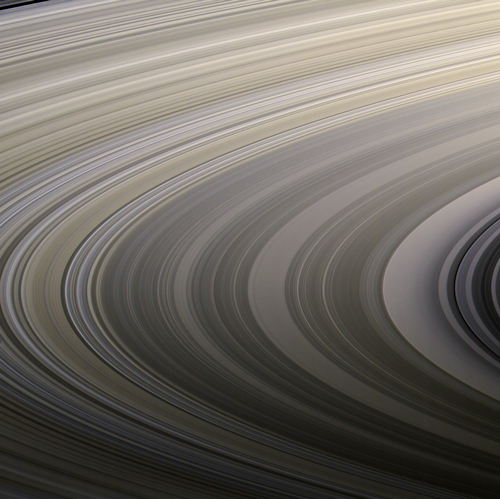
In addition, “there are clear indications of episodic transfer of material from the C ring to the D ring,” Waite said. But he said that there are no known ways to transfer material from the A and B rings, which contain the vast majority of the ring system’s mass, to sustain the lighter inner rings.
That balance of infalling ring material versus additions to the ring system from comets and meteoroids leaves the fate of the rings a bit uncertain, although Mitchell said that they probably won’t live that much longer—by astronomical standards.
“Originally, it was estimated that the rings were born four and a half billion years ago and stayed pretty stable,” Mitchell said. “But it looks like they’re fairly recent. And if you calculate all the losses from the rings, they probably won’t be around for more than another hundred million years or so, which is much shorter than the lifetime of the solar system. So that argument is pretty much settled.”
“Perhaps we should appreciate the rings a little bit more the next time we look at them through a telescope,” said Militzer with a chuckle. “This is a special moment—the rings won’t be around forever.”
—Damond Benningfield ([email protected]), Science Writer
Citation:
Benningfield, D. (2019), How Cassini ran rings around Saturn and what it helped us learn, Eos, 100, https://doi.org/10.1029/2019EO126517. Published on 03 July 2019.
Text © 2019. The authors. CC BY-NC-ND 3.0
Except where otherwise noted, images are subject to copyright. Any reuse without express permission from the copyright owner is prohibited.

